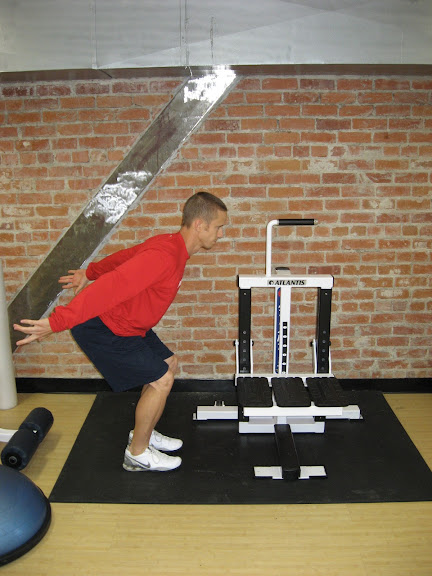Think it's too easy to do any good? Think again...I've used it to increase my athletes' vertical by as much as 3 inches in one month. Listen, when you utilize the correct muscles, train them to fire in the correct direction at the appropriate time...improved performance results.
Key Coaching Points:
1. Posture and alignment should be maintained throughout.
2. Focus on hip loading more than knee loading initially (hips back instead of knees forward) to maximize glute, hamstring and groin power.
3. No Countermovement. At least a 2 second pause in the squatted/hip loaded position at initiation must happen prior to take off.
4. Until you can land all jumps perfectly do not add the Countermovement.
5. Land as quietly as possible.

1. Neutral Spine (all 4 curves that exist in your spine should be in your spine). Don’t slouch, round out, or flatten the spine.
2. Draw in. Keep your belly button pulled in toward your spine tight. This engages the transverse abdominals and stabilizes the spine and hips and increases power development.
3. Alignment. Knees should be lined up with toes, feet flat (but pressure toward ball of foot).
4. ¼ to ½ Squatted depth in a Hip Loaded position. Here’s the easiest way to figure out if you’ve got it. Stand face up to a wall with toes no further than 1” away from wall. Can you squat down to a ¼ or ½ squat position without falling backward or losing knee toe alignment. Use that as your guide.
5. Arms back.
6. Feet hip to shoulder width (hint: your shoulders aren’t as wide as you think).

Take Off:
1. Explode upward: Fully extend legs, drive hips forward and swing arms up to the sky.
2. Try to get your body fully extended in the air prior to landing.
3. Maintain posture and alignment as you leave the ground.
Finish Position:

1. If you landed like you started you’re on the right track. Everything you started with should be the way you finish (alignment, posture, draw in, etc.).
2. Land as quietly as possible: if you can land quietly chances are you are doing a good job controlling the movement with your muscles (avoids injury and prolongs your career). If you can’t do that, get ready for joint pain in 2 years…and for the rest of your life.
3. Arms forward: allow your arms to be out in front of your body at the finish to counter balance your body.
4. Get your foot flat: not on impact, but as you come down into your squat. I see many athletes make the mistake of trying to stay on the balls of their feet. Don’t. It’s not better.

No comments:
Post a Comment